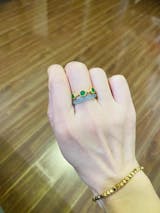This pendant looks great and feels really well-made. It’s become my go-to piece for both casual and dressy outfits.
This ring feels solid and looks way better than I expected. Perfect for daily wear and special meaning.
Great quality and the craftsmanship blew me away. It’s comfortable on the thumb and gets noticed.
Such a nice color and the craftsmanship is spot on. I get compliments every time I wear it.
They look even better in person — very soft, elegant style. I’m super happy with these earrings.






























































